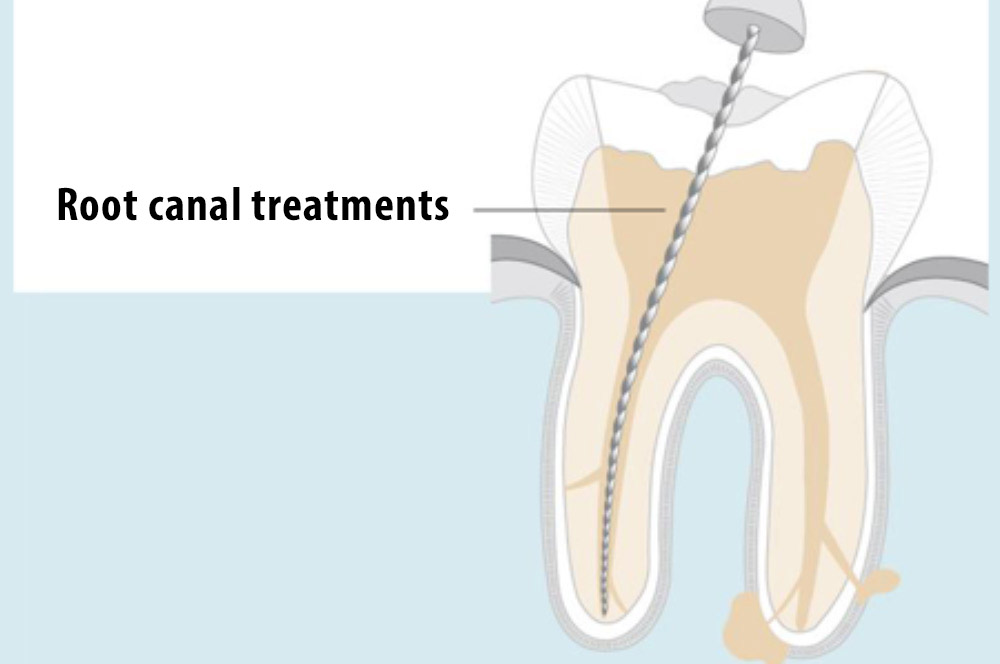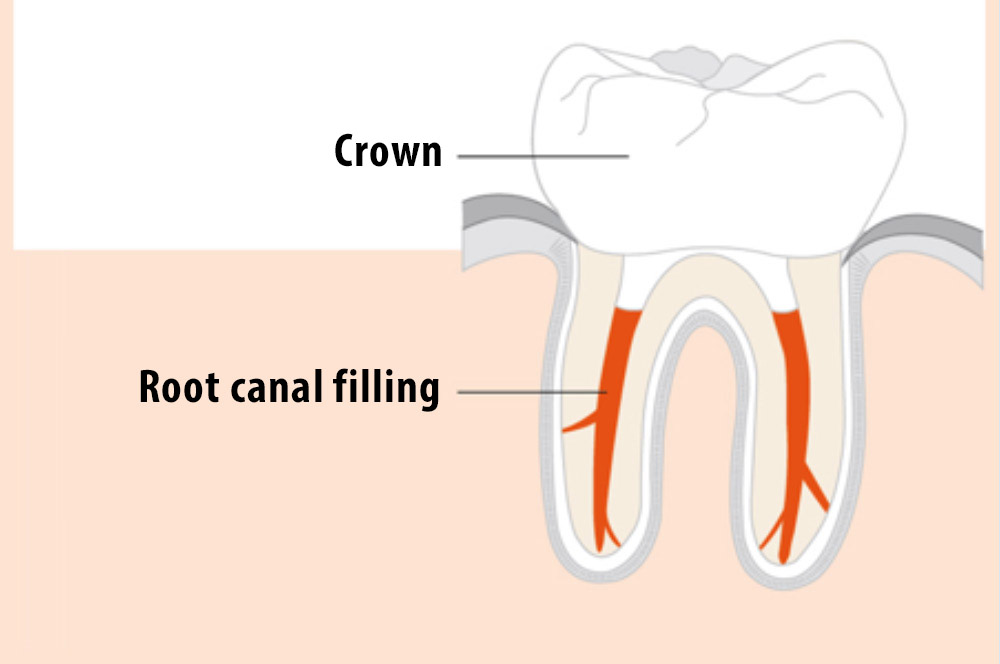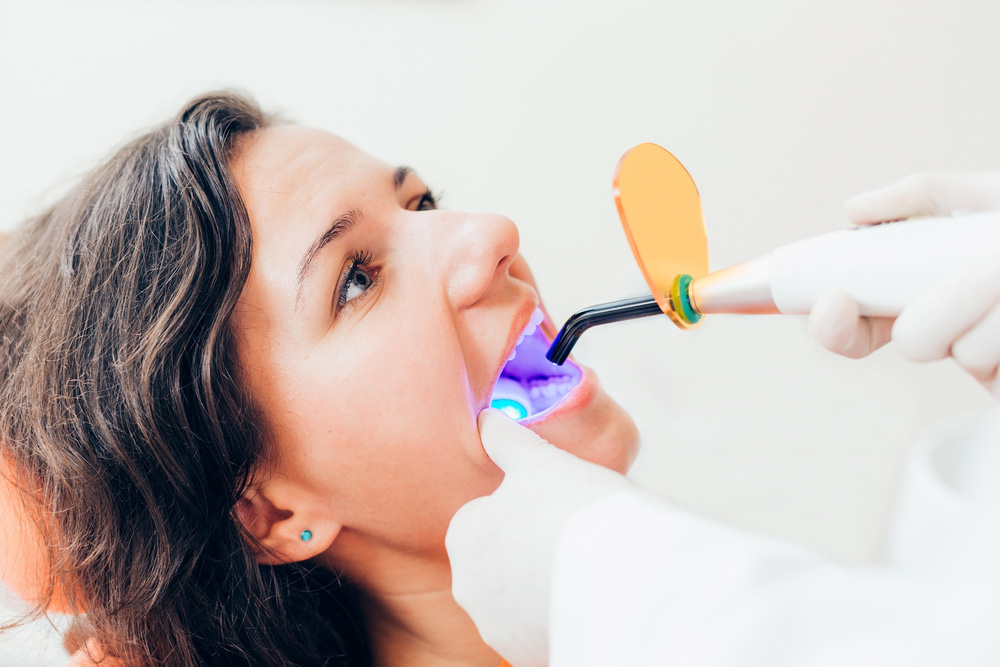Conservative dentistry is the branch of dentistry which aims to keep the teeth in the mouth as long as possible. The goal of the conservative treatments is to correct the not too severe defects of the teeth thereby restoring their function and esthetical appearance. Most of the conservative treatments are done under local anesthesia and are completely painless.
ROOT CANAL TREATMENT
If the decay or the traumatic injury of the tooth is too extensive performing a root canal treatment could be necessary. The main cause of root canal treatments is the inflammation of the pulp, caused by bacteria from the deep carious lesion. These bacteria spread trough the root canal and penetrate into the canal walls, the tissues found inside the pulp chamber and the root canals get infected, and this causes severe sharp pulsating pain originating from the infected tooth. During the treatment we gain access to the root canal (canals) and clean them. The front teeth usually have one, the premolars one-two, and the molars three or four root canals. We clean the whole length of the canals by removing the debris and disinfecting the thoroughly. The root canal treatment eliminates the bacteria found in the root canals. Prior the root canal treatment we make a periapical X-ray of the affected teeth to evaluate the status and the direction of the roots and the root canals.


ROOT CANAL FILLING
Usually we put a “medicament filling” in the root canals after the cleaning and the disinfecting to prevent the progression of the inflammation and to cease the pain
The permanent root canal filling is applied after the root canal treatment (and if needed after the “medicament filling”) If the root canal treatment is necessary due to a traumatic injury and the treatment is performed immediately after the injury there is a chance to skip the “medicament filling” and to start with the permanent filling material. It is very important to cover the permanent root canal filling as soon as possible with proper coronal restoration (composite filling, inlay, crown, etc…) the ensure a good sealing and to prevent the leakage of the bacteria.
After the root canal filling we make a new periapical X-ray to assess the quality of the endodontic treatment.
ESTHETIC FILLING
The “white” fillings dominated over the grayish amalgam fillings over the last decade in the up-to-date practices. The unique properties of the esthetic white fillings enable us to make the defects of the teeth invisible.
The esthetic fillings are suitable for the treatment of the minor and medium cavities in the front-, and also in the posterior region. These fillings consist of light-cured composite material in shades mimicking the natural color of the teeth. They attach leakage free with a very high bonding strength to the tooth structures. Most of the esthetic composite filling materials cure in the NUV (near ultraviolet) light spectrum. The dentist applies the composite in thin layers (<2mm) to ensure that the material is completely, – in his whole dept – cured. These fillings are very long lasting and have excellent esthetic properties.
The dentist polishes the surface of the filling after the cavity is filled properly with the composite. The aim of polishing the filling is to ensure that there is no edge or irregularity between the composite and the tooth, thereby minimalising the chance of discoloration or the development of secondary caries.

INLAY, ONLAY
Inlay: It is advised to choose an inlay for the final restoration if the tooth has extensive decay (the majority of the tooth’s surface lost) or after a root canal treatment was performed. The inlay is a special kind of filling, where the restoration is made individually by a dental technician and then cemented permanently in the previously prepared cavity. The technician works on a gypsum cast made from the impression taken by the dentist during the first visit. The inlay can be made of various materials (composite, ceramic, gold). The gold has excellent properties, it is very ductile and this enables to minimalise the chance of even the smallest irregularities left between the inlay and the tooth. Contrary lot of the patients are not satisfied with it’s unique color, they find it unesthetic. This problem can be easily solved if choosing a composite or ceramic inlay. These materials provide restorations that are even for dentist hard to recognize.
Onlay: For the restorations made in cases where the damage is very severe and the inlay covers or reaches beyond the cusps of the tooth we use the term onlay or overlay.
Advantages of inlays: They can mimic every shade of the teeth, they fit very precisely, they withstand abrasion, they have a high resistance against breakage and they keep their color permanently. The inlay is made in a dental laboratory. This enables to make a much more precise restoration. The cementing of the inlays only take a few minutes which also reduces the risk of the development secondary caries. The inlays can last much longer compared to the restorations made directly inside the oral cavity.
TEETH WHITENING/BLEACHING
The bleaching of the discolored teeth counts as an everyday procedure in daily work of the dental practices. Bleaching counts as a perfectly safe cosmetic treatment thanks to the continuously evolving teeth whitening systems.
Professional whitening
The professional teeth whitening performed at the dental practice is done with a special UV-lamp and a concentrated whitening substance. First we clean the surface of the teeth and prepare it for the whitening, then we apply the substance and activate it with the UV-lamp. Depending on the expected result this is repeated 1-2 times. The advantages of the professional teeth whitening is that it can be performed within 1 hour, and also the intensity of the whitening is adjustable, so the expected tooth color can be selected prior the treatment.
The stains caused by coffee, tea and cigarettes disappear and the originally grayish, yellowish teeth became white. Even discolorations caused by medicaments can be managed with the professional teeth whitening.
At-home whitening
We make an individual elastic mouthpiece (tray) that fits perfectly on the patient’s teeth, and we fill it with the whitening gel. Then we put the mouthpiece in the mouth of the patient. Regularly worn this provides the expected result within 1-2 weeks. This kind of treatment can be supported also with professional bleaching when we want to renew the color of the teeth for a special occasion (wedding, vacation, prom).
Whitening of root canal treated teeth
Almost all of the teeth change their color after root canal treatment. This could be very disturbing in the esthetic region. During the whitening we treat these teeth also from the inside. We remove the filling covering the root canal filling material and apply some whitening gel in this newly formed








